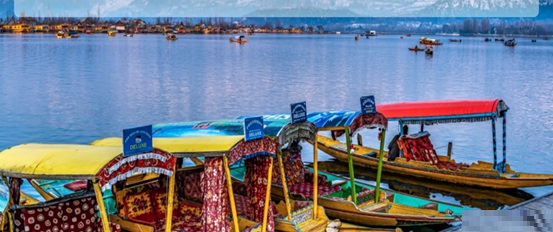(Prelims: Current Affairs)
(General Studies Paper-2: Functions of the Union and the States, Issues and Challenges related to the federal structure, Transfer of powers and finances to the local level and its challenges.) |
Context
On 5 August 2019, the state was divided into the Union Territory of Jammu and Kashmir and the Union Territory of Ladakh by repealing Articles 370 and 35A through the Jammu and Kashmir Reorganisation Act, 2019.

About Article 370
- Article 370 gave special status to Jammu and Kashmir in the Indian Constitution.
- This provision was temporarily included in 1949 and provided the state with its own constitution, separate flag and autonomy in many matters.
Abolition
- On 5 August 2019, the Government of India issued a Presidential Order (The Constitution (Application to Jammu and Kashmir) Order, 2019) nullifying Article 370.
- Also, the Jammu and Kashmir Reorganization Act, 2019 was passed, under which the state was divided into the following two union territories:-
- Jammu and Kashmir (with assembly)
- Ladakh (without assembly)
Main provisions
- Article 35A was automatically abolished, which determined the special rights of the "permanent residents" of Jammu and Kashmir.
- All central laws are now applicable in Jammu and Kashmir and Ladakh.
- The system of separate flag and constitution ended.
- Equality for citizens of the whole country in land purchase, government jobs and other rights.
Importance
- National integration: Full inclusion of Jammu and Kashmir into the Indian Union.
- Legal equality: equal laws and rights for all citizens.
- Development prospects: boost to investments, infrastructure and tourism.
- Security impact: part of strategy to weaken terror networks.
Implications for Jammu and Kashmir
Governance and political changes
- Assembly dissolved; Union Territory under administration of Lt. Governor.
- Delimitation process completed (2022): seats in J&K Assembly increased from 83 to 90; seats reserved for SC/ST.
- Panchayati Raj institutions strengthened, but assembly elections yet to be held.
- Control over police and services given to Lt. Governor, limiting powers of elected government.
Security situation
- Reduction in stone-pelting incidents and street protests after 2019.
- Terror-related incidents have reduced, but targeted killings of civilians (especially minorities) still continue.
- Tighter border security has led to fewer cross-border infiltration attempts.
Economy and development
- Increased central funding for infrastructure, roads, health and education.
- Investment: The Centre launched a new industrial scheme in 2021, promising incentives to attract investments.
- Proposed investments in J&K now total Rs 1.63 lakh crore, of which over Rs 50,000 crore are in various stages of operationalisation.
- Production has already started in 359 industrial units; another 1,424 units are in the final stages of completion.
- The new industrial policy is attracting investment proposals worth thousands of crores of rupees, although implementation on the ground is slow.
- Farmers will benefit from direct market linkages (e.g., GI-tagged saffron, horticulture exports).
- Revenue: J&K has seen a sharp increase in tax revenues. GST collections are set to grow by 12%, excise duty by 39% and overall non-tax revenue by 25% between 2022 and 2024.
- The state's GDP is set to double from Rs 1.17 lakh crore in 2015-16 to Rs 2.45 lakh crore in 2023-24 and Rs 2.63 lakh crore in 2024-25.
- Electricity: Following reforms in the power sector, 5.74 lakh smart meters were installed by mid-2024, reducing transmission and distribution losses by 25%.
- According to sources in the Jammu and Kashmir administration, power generation is expected to double by December 2026.
- The government has spent about Rs 10,000 crore on strengthening the transmission and distribution infrastructure.
Tourism growth
- Record tourist arrivals in 2023-24 (over 2 crore visitors), including foreign tourists.
- Boosted by improved connectivity (new highways, upgraded Srinagar airport).
- Bollywood productions coming back to the forefront due to film shooting incentives.
Social indicators and welfare
- Expansion of all central laws and schemes (e.g., Right to Education, Forest Rights Act, SC/ST reservation benefits).
- Upgradation of healthcare facilities; expansion of coverage of Ayushman Bharat.
Challenges
- Political vacuum due to lack of elected assembly.
- Alienation among certain sections of the population; political mobilisation.
- Security concerns due to sleeper cells and cross-border networks
- Sustained private investment needed for job creation.



